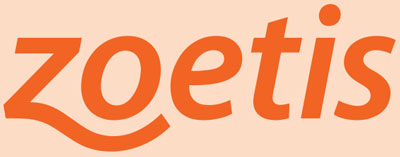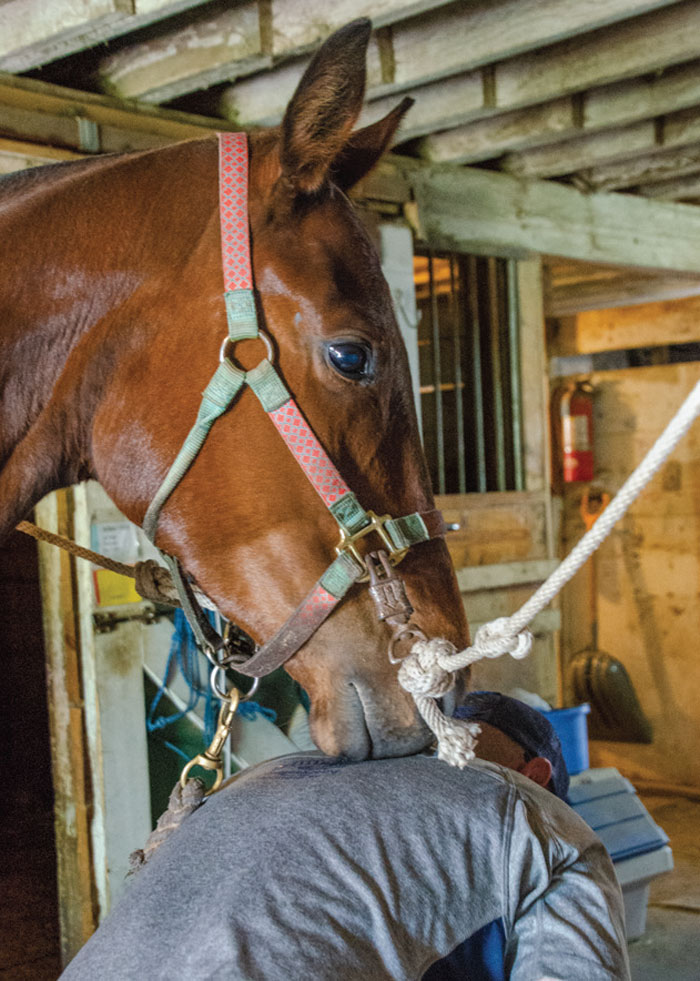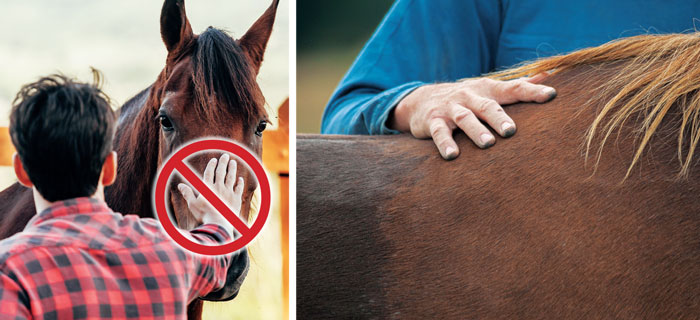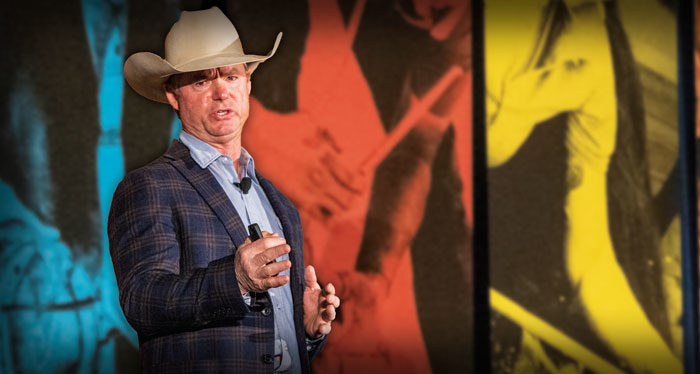You know as well as anyone that today’s society is dramatically different than it was even just a decade ago. Few children grew up on ranches or farms. They don’t get up early to feed the chickens or milk the cows. But they are buying horses and becoming professionals who work with horses.
“There are some people becoming veterinarians with no livestock handling experience at all,” Chris Cox, a professional horseman and founder of Chris Cox Horsemanship told attendees at the 2023 International Hoof-Care Summit in Cincinnati, Ohio. “There are farriers with very little livestock handling, too. When I talk about livestock handling, it’s not just a horse, but learning how to read horses and their instincts.”
Despite the lack of experience, the industry relies on people without this first-hand knowledge to join the ranks so that it can survive. Putting yourself in a compromising situation because you feel pressured for time or money, or because a horse is misbehaving, can quickly become a situation that jeopardizes your career. And you can’t rely on the handler anticipating and responding to a horse’s reaction that could hurt you.
Takeaways
- Meet with new clients before working on their horses. Explain your process and expectations.
- Fear, anxiety and tension start in the horse’s mind and flow through its body to his feet. Understanding a horse’s mindset, where its thoughts are, can prevent injuries.
- More than anything, horses crave rhythm, a tempo starting with how they are approached to how they are handled, trimmed and shod.
“Productivity and safety go together,” Cox says while delivering Focus on Farrier Safety, presented by Zoetis. “Being effective and safety go together. Learning how to read an animal and knowing a little bit about the instincts of horses is as important as your relationship with the client.”
Setting Expectations
Without boundaries, people and horses alike won’t know what is or isn’t acceptable. Uncertainty can also create confusion and lead to distrust. It’s certainly not easy telling people what to do, especially if they are accustomed to directing others, but defining expectations is essential. For example, at Cox’s clinics, the group sits in chairs without horses and he asks attendees several questions while observing their mannerisms.
“I get to know their personalities, and I can tell by their body language how much pressure it is going to take to make a change,” he says. “Then I talk to them. I prepare them, telling them what is going to happen.”
For example, he says, “I’m going to teach you. Then after I’ve taught you, I’m going to ask you. If you haven’t responded to the ask, I’m going to tell you. If you haven’t responded to the tell, I’m going to correct you.”
Arranging a meeting and describing your expectations with new clients or clients with new horses can be beneficial for farriers, too. During the conversation, share your prices, explain your process for handling a misbehaving horse (or handler), and discuss the next steps, such as sending the horse out for training, if the corrections aren’t enough.

Focus on Farrier Safety
Professional horseman Chris Cox insists that farriers have a safe environment to work in. This is mandatory with the training of horses. In a special session at the 2023 International Hoof-Care Summit, "Focus on Farrier Safety: Understanding the Small Details of Equine Body Language," sponsored by Zoetis, Cox discusses how he evaluates the behavioral instincts of individual horses from the horseman's perspective to prepare for working on the feet.
More information is available on the Zoetis Farrier Resources page.
“A professional meeting sets a standard right off the bat,” Cox says. “It is so important because you might show up to a person’s barn, get the horses out, and find out they have unreal expectations.”
Following through is equally as important as establishing the standard upfront. Cox uses the example of a horse nuzzling all over you while you work.
You ask the handler to keep the horse’s head off you and they respond with, “Don’t worry about Fluffy, he won’t hurt you, will you Fluffy?”
Then you ask again, “Please, I just ask you to keep him off of me.” The client responds, “Sure yeah, I’ll watch him.”
But they don’t.
Cox suggests stopping and saying, “My safety and what I do for a living is very important. I have boundaries. The quiet horses are the ones that have gotten me hurt. The spoiled horses have gotten me hurt. I just need you to respect my wishes for my safety.”
“That's a hard conversation, right?” Cox says. “Your standards aren’t the owner’s standards or the handler’s standards. But nobody wins if you get hurt, or the horse gets hurt.”
Creating a Relationship with the Horse
Setting standards is only one part of the safety equation for Cox. Another is reading body language, understanding where the horse carries tension and establishing a relationship of trust. Horses carry fear in their feet, but that’s not where the anxiety originates, he says.

Behaviors such as nuzzling while you work could jeopardize your safety. Farriers should establish expectations to avoid such behaviors with horse owners. Photo by: Jeff Cota
“I can show you instances over and over again that it’s not the foot,” Cox says. “It starts in the mind, moves through the body and comes out in the feet.”
Some of the simplest interactions can create the most stress for horses. Approaching a horse is one example Cox offers. Many people walk directly to a horse and rub its nose. It may not seem like a big deal, but think how would you respond if someone walked up to you and rubbed your nose to say hello?
“The sensitivity of a horse’s skin is about eight times that of a human,” he says. “Going up and just rubbing on their nose, you’re going to develop something. There are two places I start. I scratch them on their withers, just like a mother does a foal, and I place my hand on the side of their neck or their back so they can feel my energy.”
He acknowledges that some people might not believe in horses reading humans, but horses and their reactions to people are structured around body language and rhythm.
“You’ve seen people send their negative energy right through that horse, and that horse will start pawing or walking around,” Cox says. “It’s equally important in how you carry yourself into a situation, too.”
“When you release them at the time of the bad behavior, they will be resistant the next time…”
That starts with greeting the horse, he says. Most people — horse owners, veterinarians, farriers and trainers alike — skip introducing themselves to the horse and immediately reach to pick up a leg. Instead, Cox suggests touching the horse first to give it a heads up, which signals to the horse, “Hey, you’re OK.”
“I relate to this a lot,” Cox says. “I remember one time my dad and I were coming off this mountain. We had a load of horses on this big flat deck. It was raining and that truck was going all over the road. He could see I was afraid, he reached over there and put his hand on my shoulder, and he said, ‘You’ll be OK.’ I grew armor and knew it would be alright.”
Horses are the same way. If you can reassure them that they’re OK, you'll be surprised how much you can get done, Cox says. This is especially important when adding a new horse to your schedule.
Often, the owner places their horse in cross-ties, and the farrier gets right to work. Not every horse, especially those in the Western industry, is used to cross-ties. As a result, an unintended consequence is that cross-ties can create tension.
Cox starts by feeling the horse out on a lead rope by laying his hands on the horse, patting it, and looking it in the eye to see how reactive it is.
“I’m going to start at the nose,” he says. “The nose has everything to do with the kick. The head, the nose and these shoulders dictate the direction of where those hind feet are.”
More than anything, horses crave rhythm. What is rhythm? Rhythm is the tempo at which you start something, stop, start again, and then stop. Cox sees many people approach with their hands up, without a rhythm, saying, “Whoa. Whoa. Whoa.”
“I treat the horse like a human,” he explains. “When I walk up, I keep a rhythm and approach the horse at an angle, which is a less defensive position. It might not be super-fast, and I’m never going to walk up with my hands up at their head. I’m going to relax my body.”
Learn More Online
Gain more insight on how horsemanship can improve your production and safety by watching & reading:
- “How Reading the Horse Can Make Your Job Easier,” in which experts explain why a horse’s body language can help you understand what frame of mind it’s in.
- “Basics of Horsemanship for the Farrier,” in which it’s explained why appropriate handling and communication skills prevent injury.
- “You Can’t Hurry Horsemanship,” in which Arizona horseman James Wyatt Weatherford explains why shortcuts only lead to serious injury.
- "Understanding the Small Details of Equine Body," In this multimedia session, he will discuss how he evaluates the behavioral instincts of individual horses from the horseman’s perspective
When Cox starts colts and works on his horses, he eventually gets them to a point where they remain relaxed as he approaches them. He even jogs up to some to teach them not to be afraid. Horses, particularly young ones and those with bad manners, hate unmanaged rhythm.
Curing the Leaner
Making the horse feel comfortable not only makes them more cooperative, but it can also cure the habit of a horse that leans on you. When a horse rests on you, it’s no different than a horse that drops its shoulder and knocks a barrel, shoulders into a cow or hits your leg on a gate. It’s about body control and keeping the horse balanced on the ground or on its back.
“You know there’s nothing worse than a horse leaning on you,” Cox says. “But I’ve seen some good farriers put a horse in an uncomfortable position for its conformation and height. Let the horse find a position where you’re not pulling on their elbow or their shoulder, or pulling them off balance — they will have to move their feet to get comfortable.”
Anytime a horse is unbalanced, it is going to lean, and the more you lean back on it, the more it will lean on you. In these situations, Cox squares the horse so it picks up its shoulders to distribute their weight evenly on their feet.
“For some of these horses, I’ll put a bridle on them, just a snaffle, and hook a lead to it and get it to balance itself,” he says. “In horses that don’t have good ground manners, I’ve seen their minds change a bit when they have a bridle on.”
Building a relationship with a horse continues with how the leg is handled once the foot is done. Cox keeps his hand on the leg until the foot touches the ground.
“You’ve said to the horse, ‘OK, relax, give me your foot, soften up,’” he says. “When you drop that leg off that stand, or you drop that leg, they’re going to pick it right back up because they lose their balance and you start losing a little bit of trust there.”
Developing trust is essential when trimming and shoeing a horse of any age. But it’s essential for younger horses unfamiliar with the process and the expectations you have for older horses. Taking extra time and breaks before a struggle is key, Cox says.

People often approach a horse by rubbing its nose, which can create stress for the animal. Texas horseman Chris Cox starts in two places; he places a hand on the withers and another spot on its body so it can feel his energy. These interactions calm the horse and puts it at ease. Photos by: Kleberpicui (Left) and Mark J. Barrett (right)
“Work for a few seconds, stop, put the leg down, and go to another foot,” he says. “You don’t wait for that young horse to struggle. If you wait for that horse to struggle, you better stay there and help it through the struggle. Otherwise, you’ll release them at the time of the bad behavior and then they will be resistant the next time. When I pull on the reins, and the head goes up, and I release the head, the next time, I pull on the reins, the head goes up, and then the next thing they’re rearing.”
So, when you’re working with a young horse and even a horse that is tough to work on, you don’t have to go off and do another horse. You can go to the next foot. You can mix it up and then come back.
“Keep a rhythm going, and then stop and go on to the next foot before something ever comes,” Cox says. “It’s a lot like little kids and why we only send them to school for a few hours a day at the beginning. Their attention span isn’t long enough to leave them all day.”
Working on Good Behavior
Cox acknowledges that he often gets asked, “What does working on good behavior have to do with safety?” It has everything to do with safety because being able to read the horse’s mindset is what will help keep you safe and working.
“You have to know your horses,” he says. “You know what they’re thinking because the thought starts in their brain. The next thing you can see comes to their eyes. If you miss that, it goes to their neck, body and feet. I’ve seen more people get hurt from heads than feet. The horse’s head will knock you out. It’ll hurt you, and it’s not spoken about enough, so we need to make sure that it’s respected as well.”









Post a comment
Report Abusive Comment